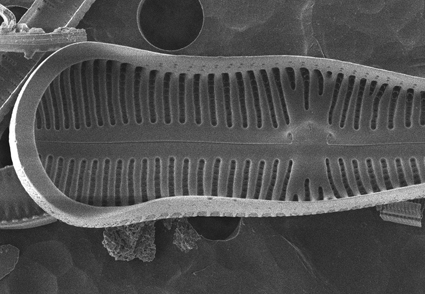Abstract
A large, unknown Gomphonema taxon belonging to the G. truncatum group was observed in a historic sample collected by William Smith during his 1854 excursion in the Auvergne (France). The unknown species presented sufficient differences with all known taxa in the truncatum-capitatum group to warrant further morphological investigations. Detailed light and scanning electron microscopy investigations in comparison with all published literature revealed that the unknown species had a unique combination of morphological (uniseriate striae, lack of well-develop headpole) and morphometric (large valve width) features. Therefore, the species is described as new: Gomphonema beaugerianum sp. nov. The new species was observed in Lac de Guéry, an oligotrophic, almost circumneutral lake in the Auvergne with a high ecological quality.
References
- Abarca, N., Zimmermann, J., Kusber, W.-H., Mora, D., Van, A.T., Skibbe, O. & Jahn, R. (2020) Defining the core group of the genus Gomphonema Ehrenberg with molecular and morphological methods. Botany Letters 167 (1): 114–159. https://doi.org/10.1080/23818107.2019.1694980
- Agardh, C.A. (1830) Conspectus criticus diatomacearum. Part 1. Lundae [Lund]: Literis Berlingianus. pp. 1–16.
- Chudaev, D.A. & Gololobova, M.A. (2012) Frustule morphology of species of the genus Staurosira sensu stricto (Bacillariophyceae) from the Lake Glubokoe (Moscow Region). Novosti Sistematiki Nizshikh Rastenii [Novitates Systematicae Plantarum Non Vascularium] 46: 68–84. https://doi.org/10.31111/nsnr/2012.46.68
- Cox, E.J. & Ross, R. (1981) The striae of pennate diatoms. In: Ross, R. (Ed.) Proceedings of the Sixth Symposium on Recent and Fossil Diatoms. Budapest, September 1–5, 1980. Taxonomy, Morphology, Ecology, Biology. Otto Koeltz, Koenigstein. pp. 267–278.
- Ehrenberg, C.G. (1832) Über die Entwickelung und Lebensdauer der Infusionsthiere; nebst ferneren Beiträgen zu einer Vergleichung ihrer organischen Systeme. Abhandlungen der Königlichen Akademie Wissenschaften zu Berlin, Physikalische Klasse 1831: 1–154.
- Ehrenberg, C.G. (1838) Die Infusionsthierchen als vollkommene Organismen. Ein Blick in das tiefere organische Leben der Natur. Leipzig: Verlag von Leopold Voss. pp. I–xviii, [1–4], 1–548. https://doi.org/10.5962/bhl.title.58475
- Ehrenberg, C.G. (1840) Characteristik von 274 neuen Arten von Infusorien. Bericht über die zur Bekanntmachung geeigneten Verhandlungen der Königlich-Preussischen Akademie der Wissenschaften zu Berlin 1840: 197–219.
- Ehrenberg, C.G. (1843) Verbreitung und Einfluss des mikroskopischen Lebens in Süd- und Nord-Amerika. Abhandlungen der Königlichen Akademie der Wissenschaften zu Berlin 1841: 291–445.
- Heiberg, P.A.C. (1863) Conspectus criticus diatomacearum danicarum. Kritisk oversigt over de danske Diatomeer. Kjøbenhavn: Wilhelm Priors Forlag. pp. 1–135, 6 pls. https://doi.org/10.5962/bhl.title.68738
- Heudre, D., Wetzel, C.E., Moreau, L. & Ector, L. (2017) Diatoms of Gérardmer Lake (Voges, France). Nova Hedwigia Beiheft 146: 253–277. https://doi.org/10.1127/1438-9134/2017/253
- Krammer, K. (2003) Cymbopleura, Delicata, Navicymbula, Gomphocymbellopsis, Afrocymbella. Diatoms of Europe 4: 1–529.
- Kulikovskiy, M.S., Kociolek, J.P., Solak, C.N. & Kuznetsova, I. (2015) The diatom genus Gomphonema Ehrenberg in Lake Baikal. II. Revision of taxa from Gomphonema acuminatum and Gomphonema truncatum-capitatum complexes. Phytotaxa 233 (3): 251–272. https://doi.org/10.11646/phytotaxa.233.3.3
- Kützing, F.T. (1844) Die kieselschaligen Bacillarien oder Diatomeen. W. Köhne, Nordhausen, 144 pp. https://doi.org/10.5962/bhl.title.64360
- Lange-Bertalot, H. (1993) 85 neue Taxa und über 100 weitere neu definierte Taxa ergänzend zur Süsswasserflora von Mitteleuropa, Vol. 2/1-4. 85 New Taxa and much more than 100 taxonomic clarifications supplementary to SüBwasserflora von Mitteleuropa Vol. 2/ 1-4. Bibliotheca Diatomologica 27: 1–454.
- Lange-Bertalot, H., Hofmann, G., Werum, M. & Cantonati, M. (2017) Freshwater benthic diatoms of Central Europe: over 800 common species used in ecological assessment. English edition with updated taxonomy and added species. Koeltz Botanical Books, Schmitten-Oberreifenberg, 942 pp.
- Levkov, Z., Mitic-Kopanja, D. & Reichardt, E. (2016) The diatom genus Gomphonema in the Republic of Macedonia. Diatoms of Europe 8: 1–552.
- Mayer, A. (1917) Beiträge zur Diatomeenflora Bayerns. Part I, A. Bacillariales aus dem Fichtelgebirge und angrenzenden Gebieten. B. Bacillariales aus dem Bayrischen Walde. Denkschriften der Königlich-Baierischen Botanischen Gesellschaft in Regensburg 13: 1–99.
- Reichardt, E. (1999) Zur Revision der Gattung Gomphonema. Die Arten um G. affine/insigne, G. angustatum/micropus, G. acuminatum sowie gomphonemoide Diatomeen aus dem Oberoligozän in Böhmen. Iconographia Diatomologica 8: 1–203.
- Reichardt, E. (2001) Revision der Arten um Gomphonema truncatum und G. capitatum. In: Jahn, R., Kociolek, J.P., Witkowski, A. & Compère, P. (Eds.) Lange-Bertalot Festschrift. Studies on diatoms dedicated to Prof. Dr. Dr. h.c. Horst Lange-Bertalot on the occasion of his 65th birthday. Ruggell: A.R.G. Gantner Verlag K.G. pp. 187–224.
- Reichardt, E. (2018) Die Diatomeen im Gebiet der Stadt Treuchtlingen. Vol. 1 and 2. Bayerische Botanische Gesellschaft, München, 1184 pp.
- Rioual, P. (2002) Limnological characteristics of 25 lakes of the French Massif Central. Annales de Limnologie - International Journal of Limnology 38 (4): 311–327. https://doi.org/10.1051/limn/2002026
- Ross, R., Cox, E.J., Karayeva, N.I., Mann, D.G., Paddock, T.B.B., Simonsen, R. & Sims, P.A. (1979) An amended terminology for the siliceous components of the diatom cell. Nova Hedwigia, Beiheft 64: 513–533.
- Roth, A.W. (1797) Catalecta botanica quibus plantae novae et minus cognitae describuntur atque illustrantur. Fasc. 1. Lipsiae [Leipzig]: in Bibliopolo I.G. Mülleriano. pp. [i]–viii, [1]–244. https://doi.org/10.5962/bhl.title.124909
- Round, F.E., Crawford, R.M. & Mann, D.G. (1990) The Diatoms - Biology and morphology of the genera. Cambridge, Cambridge University Press.
- Smith, W. (1855) Notes of an excursion to the south of France and the Auvergne in search of Diatomaceae. Annals and Magazine of Natural History, series 2 15: 1–9. https://doi.org/10.1080/037454809495381
- Turland, N.J., Wiersema, J.H., Barrie, F.R., Greuter, W., Hawksworth, D.L., Herendeen, P.S., Knapp, S., Kusber, W.-H., Li, D.-Z., Marhold, K., May, T.W., McNeill, J., Monro, A.M., Prado, J., Price, M.J. & Smith, G.F. (eds.) (2018) International Code of Nomenclature for algae, fungi, and plants (Shenzhen Code) adopted by the Nineteenth International Botanical Congress Shenzhen, China, July 2017. Regnum Vegetabile Vol. 159. Glashütten, Koeltz Botanical Books. pp. [i]–xxxviii, 1–253. https://doi.org/10.12705/Code.2018
- van der Werff, A. (1955) A new method of concentrating and cleaning diatoms and other organisms. Verhandlungen der internationalen Vereinigung für theoretische und Angewandte Limnologie 12 (1): 276–277. https://doi.org/10.1080/03680770.1950.11895297
- Van Heurck, H. (1885) Synopsis des Diatomées de Belgique. Texte. Anvers: Martin Brouwers & Co. pp. [1]–235. https://doi.org/10.5962/bhl.title.1990
- Williams, D.M. & Round, F.E. (1988) Fragilariaforma, nom. nov., a new generic name for Neofragilaria Williams & Round. Diatom Research 3 (2): 265–267. https://doi.org/10.1080/0269249X.1988.9705039


